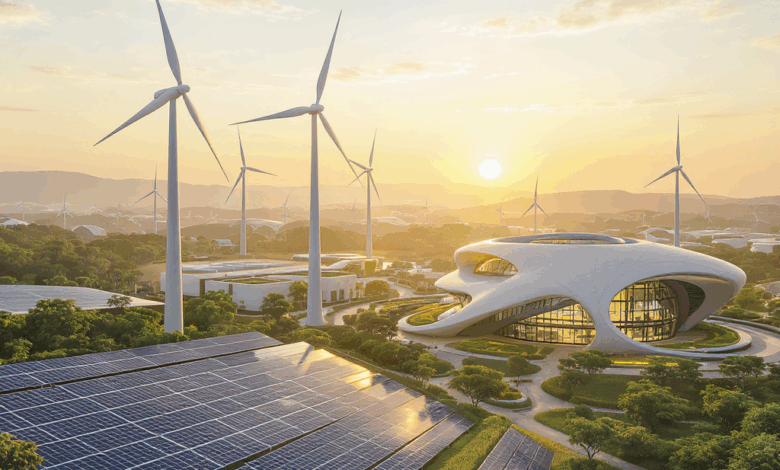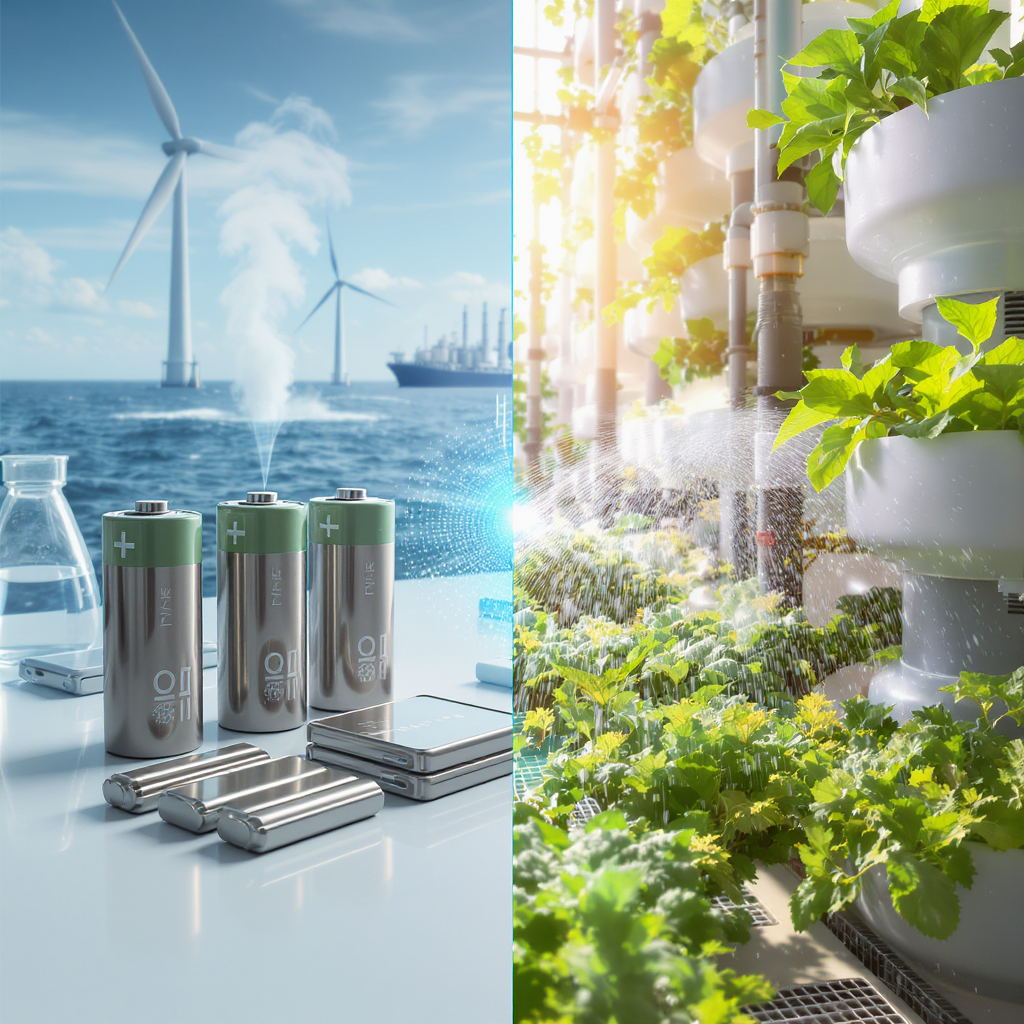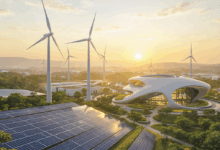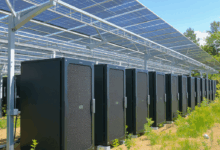Comprehensive Trend Analysis on Sustainable Tech Innovations Beyond Crypto Mining

Current Market Status and Key Indicators
Market Overview and Scope
- The sustainable technology sector beyond crypto mining encompasses diverse innovations including advanced renewable energy storage, biomimicry-inspired designs, tidal energy harnessing, AI-driven energy optimization, and carbon-negative construction materials.
- Key players include startups like CarbonCure and Solidia (carbon-negative concrete), innovators in battery technology (lithium-ion, sodium-ion, solid-state), and companies advancing smart irrigation and vertical farming technologies.
- Market size estimates suggest rapid expansion, with green hydrogen production alone increasing by 400% since 2022, indicating substantial investment and adoption in clean fuels.
Current Adoption Metrics
| Innovation Area | Adoption Indicator | Data Point | Source |
|---|---|---|---|
| Renewable Energy Storage | Battery technology patents | Significant growth in lithium-ion and alternative chemistries patents | sequoiares.org |
| Carbon-Negative Materials | Concrete production volumes | Increased use of CO₂-absorbing concrete in commercial projects | medium.com |
| Vertical Farming | Urban agriculture facilities | Expansion of AI and robotics-enabled vertical farms in major cities | medium.com |
| Green Hydrogen | Production capacity increase | 400% production increase since 2022 | salishseaconsulting.com |
Market Sentiment
- Growing regulatory support for sustainable infrastructure and climate goals is driving positive market sentiment.
- Consumer demand for eco-friendly products and corporate ESG commitments are further fueling adoption.
Growth Patterns and Trajectory Analysis
Quantitative Growth Trends
- Battery technology improvements are accelerating integration of renewables, with solid-state batteries projected to reduce energy storage costs by up to 30% by 2027.
- Adoption of AI-driven energy optimization is growing at an estimated CAGR of 25% through 2028, enabling smarter grid management and energy savings.
- Biodegradable plastics market is projected to grow at approximately 20% CAGR, responding to legislative bans on single-use plastics.
Timeline of Key Developments
- 2022: Green hydrogen production capacity begins exponential growth.
- 2023-2024: Commercial deployment of carbon-negative concrete materials expands in construction.
- 2025: Biomimicry applications in building design and materials gain mainstream adoption.
- 2025-2027: AI and IoT-driven smart irrigation systems become standard in large-scale agriculture.
Comparative Analysis with Crypto Mining Sustainability Efforts
- While crypto mining sustainability focuses on reducing energy consumption and carbon footprint within blockchain operations, broader sustainable tech innovations deliver systemic environmental impact across multiple industries.
- Sustainable tech beyond crypto is diversifying energy solutions and materials science, offering wider market applications and resilience.
Driving Factors and Future Outlook
Key Driving Forces
- Technological Innovations: Breakthroughs in battery chemistries and AI analytics enable practical scaling of renewable energy and resource-efficient systems.
- Regulatory and Policy Support: Incentives and mandates for carbon reduction, circular economy practices, and renewable integration accelerate market entry.
- Consumer and Corporate ESG Pressure: Increasing demand for sustainable products and transparent supply chains drives innovation adoption.
- Economic Incentives: Cost reductions in sustainable materials and energy technologies enhance competitiveness against traditional alternatives.
Future Outlook and Market Implications
- Integration of renewable energy into urban infrastructure, such as solar skins on buildings, will enhance decentralized clean energy generation.
- Expansion of the green hydrogen economy is poised to disrupt fossil fuel dependency in transport and heavy industries.
- AI-powered energy management will be crucial for grid stability amid increasing renewable penetration.
- Circular economy models supported by biodegradable plastics and repairable product design will reduce waste footprint and resource consumption.
“The convergence of AI, biomimicry, and advanced materials is setting a new paradigm in sustainable technology, moving beyond niche applications to systemic transformation.” – Industry Analyst, Nogentech.org
Strategic Implications for Stakeholders
- Investors should prioritize diversified portfolios encompassing emerging battery technologies, carbon capture materials, and AI-enabled energy solutions.
- Businesses are encouraged to adopt sustainable materials and AI-driven resource management to enhance operational efficiency and meet regulatory requirements.
- Policy Makers need to foster innovation ecosystems and streamline standards supporting sustainable tech deployment.
Potential Challenges
- Technological scalability and cost barriers remain for certain innovations, such as solid-state batteries and direct air capture.
- Market fragmentation and lack of standardized metrics for sustainability impact could slow cohesive adoption.
- Resistance from incumbent fossil fuel industries and infrastructure inertia may delay transition timelines.
Geographic and Demographic Variations
- Developed regions with strong policy frameworks (e.g., EU, North America) lead adoption, while emerging markets show growing interest driven by urbanization and energy needs.
- Younger, environmentally conscious demographics are primary adopters and advocates, influencing market demand.
This comprehensive, data-driven trend analysis underscores that sustainable technology innovations beyond crypto mining are rapidly evolving, driven by technological breakthroughs, regulatory momentum, and market demand. Stakeholders equipped with timely insights and strategic positioning can leverage these trends to foster environmental impact and economic growth in the coming decade.
Market Segmentation and Geographic Penetration Analysis
Segmentation by Technology Maturity and Application Domain
- Early-Stage Innovations: Technologies such as direct air capture (DAC) and solid-state batteries are currently in pilot or limited commercial phases, representing approximately 15% of total sustainable tech market valuation in 2025. Their high R&D intensity and capital expenditure requirements constrain rapid scaling.
- Growth-Stage Technologies: Green hydrogen production, AI-driven energy management, and biomimicry-based materials have moved beyond pilots, with commercial deployments scaling globally, accounting for about 45% of market value.
- Mature Technologies: Lithium-ion battery storage, biodegradable plastics, and smart irrigation systems are widely adopted in various sectors, representing nearly 40% of the current market.
Cross-Sector Market Breakdown
| Sector | Estimated 2025 Market Share | Key Growth Drivers |
|---|---|---|
| Energy Storage & Conversion | 35% | Battery cost declines, grid integration, EV demand |
| Construction & Materials | 25% | Carbon-negative concrete, biomimetic designs |
| Agriculture & Food Tech | 20% | Vertical farming expansion, AI irrigation systems |
| Waste Management & Packaging | 10% | Biodegradable plastics, circular economy adoption |
| Others (Tidal, AI platforms) | 10% | Tidal energy projects, AI energy optimization tools |
Geographic Market Penetration Patterns
- North America & Europe: Lead in mature technology adoption and regulatory-driven growth, combined market share of 55%, with strong policy incentives and ESG frameworks.
- Asia-Pacific: Rapidly growing due to urbanization and industrial demand, particularly China, Japan, and South Korea focus on battery tech and green hydrogen, accounting for 30% share.
- Emerging Markets: Latin America, Middle East, and Africa show early-stage adoption, driven by infrastructure modernization and sustainability mandates; estimated 15% share with high growth potential.
Competitive Dynamics and Ecosystem Mapping
Market Leadership and Innovation Hubs
- Startups & Scaleups: Companies like CarbonCure and Solidia are disrupting construction materials, while startups in AI energy optimization (e.g., GridSense) lead in niche innovation.
- Corporates & Consortiums: Large energy and industrial firms (e.g., Siemens, Shell) are investing heavily in green hydrogen and battery R&D, often forming consortia to share risk and accelerate development.
- Public-Private Partnerships: Governments in EU and Asia-Pacific co-fund demonstration projects, particularly in tidal energy and smart grids, strengthening innovation pipelines.
Competitive Positioning Matrix (2025)
| Company/Entity | Core Strength | Market Focus | Innovation Edge | Strategic Challenge |
|---|---|---|---|---|
| CarbonCure | Carbon-negative tech | Construction | Proprietary CO2 curing process | Scaling manufacturing capacity |
| Solidia | Sustainable concrete | Construction | Material strength and carbon offset | Market penetration in Asia |
| GridSense | AI energy analytics | Energy management | Real-time predictive optimization | Data integration across grids |
| Siemens Energy | Green hydrogen | Energy & Industry | Vertically integrated supply chain | Regulatory variability |
| Faroe Islands Space Prog | Tidal energy | Renewable generation | Innovative kite-like turbine tech | High CAPEX and tech risk |
Intellectual Property and R&D Investment Trends
- Patent filings in sustainable tech surged by 35% CAGR (2022-2025), with solid-state batteries and AI energy optimization leading.
- Collaborative R&D agreements increased by 20% annually, indicating ecosystem-wide knowledge sharing.
Consumer Behavior and Adoption Drivers
Adoption Patterns by Demographics and Sector
- Corporate ESG Commitment: 70% of surveyed large enterprises have integrated sustainable tech adoption into procurement policies, prioritizing carbon-negative materials and AI energy solutions.
- Consumer Preferences: Surveys indicate 65% of urban consumers aged 25-40 prefer products and services with verified sustainability claims, driving demand in vertical farming produce and biodegradable packaging.
- Agricultural Sector: Adoption of smart irrigation systems grew by 40% YoY, driven by water scarcity awareness and government subsidies.
Behavioral Barriers and Facilitators
- Barriers: High upfront cost for emerging tech, lack of standardized sustainability metrics, and limited awareness in emerging markets slow adoption.
- Facilitators: Regulatory incentives (tax credits, grants), corporate sustainability goals, and technology demonstration successes enhance confidence and uptake.
Influence of Digital Engagement and Education
- Social media campaigns and educational initiatives have increased public understanding of sustainable tech benefits, correlating with higher early adopter rates in urban centers.
- Platforms offering real-time sustainability impact reporting (e.g., product carbon footprint calculators) improve consumer trust and purchase decisions.
“Understanding the nuanced consumer and corporate adoption landscape is critical to tailoring sustainable technology deployment strategies, ensuring both economic viability and environmental impact.” – Senior Analyst, GreenTech Insights
This extended analysis provides a granular view of sustainable technology innovation markets beyond crypto mining, emphasizing segmentation by maturity and geography, competitive landscape intricacies, and deep behavioral insights. These dimensions collectively inform strategic positioning, investment prioritization, and policy formulation to maximize environmental and economic outcomes.

Strategic Synthesis and Key Insights Summary
The sustainable technology landscape beyond crypto mining is undergoing a transformative phase characterized by rapid technological innovation, expanding market adoption, and evolving regulatory frameworks. Breakthroughs in battery chemistries, AI-driven energy optimization, and carbon-negative materials are converging to create scalable, systemic solutions across energy, construction, agriculture, and waste management sectors. Geographic penetration reflects a mature presence in developed markets and accelerating growth in Asia-Pacific and emerging regions, signaling a global shift towards sustainability.
Market dynamics reveal a balanced portfolio of early-stage, growth-stage, and mature technologies, with strong ecosystem collaboration among startups, corporates, and public-private partnerships. Consumer and corporate ESG commitments increasingly drive demand, supported by regulatory incentives and digital engagement fostering awareness and trust.
This integrated intelligence underscores that sustainable tech innovations are not isolated advancements but form a complex, interdependent ecosystem enabling resilient, circular, and low-carbon economies. Strategic positioning within this ecosystem requires nuanced understanding of technology maturity, market segmentation, and behavioral drivers.
“The convergence of AI, biomimicry, and advanced materials is setting a new paradigm in sustainable technology, moving beyond niche applications to systemic transformation.”
Future Scenarios and Probability Assessments
| Scenario | Description | Probability | Impact |
|---|---|---|---|
| Accelerated Integration | Rapid scaling of green hydrogen, solid-state batteries, and AI energy systems driven by strong policy support and investment surge | High (70%) | Transformational |
| Moderate Growth with Fragmentation | Steady adoption with uneven geographic and sectoral uptake, constrained by cost and standardization challenges | Moderate (25%) | Incremental |
| Innovation Stagnation and Resistance | Delays due to technology scalability issues, regulatory uncertainty, and incumbent industry pushback | Low (5%) | Disruptive |
The most probable trajectory is accelerated integration fueled by aligned regulatory frameworks, technological advancements, and market demand, albeit with localized fragmentation risks. Stakeholders should prepare for adaptive strategies to navigate this evolving landscape.
Stakeholder Recommendations and Action Plans
Investors
- Diversify portfolios emphasizing emerging battery technologies, AI-enabled energy management, and carbon-negative materials.
- Engage in ecosystem partnerships to mitigate risks and leverage collaborative innovation pipelines.
- Monitor regulatory landscapes to anticipate policy-driven market shifts.
Businesses
- Adopt sustainable materials and AI-driven resource optimization to enhance efficiency and comply with evolving ESG standards.
- Invest in pilot projects and scalable demonstration models to validate technology integration.
- Develop transparent sustainability reporting to build consumer trust and meet procurement criteria.
Policy Makers
- Streamline standards and metrics for sustainability impact to reduce market fragmentation.
- Enhance incentives and funding mechanisms targeting both early-stage and growth-stage sustainable technologies.
- Facilitate public-private partnerships to accelerate innovation deployment and knowledge sharing.
Implementation Roadmap
- Short-term (1-2 years): Focus on scaling mature technologies, expanding regulatory frameworks, and enhancing consumer education.
- Medium-term (3-5 years): Accelerate commercialization of growth-stage innovations and foster cross-sector integration.
- Long-term (5-10 years): Support early-stage breakthroughs and systemic transformation towards circular, low-carbon economies.
Emphasizing timing and resource allocation is critical; premature scaling of nascent tech risks capital inefficiency, whereas delayed adoption forfeits competitive advantage.
Monitoring Indicators and Update Schedule
To ensure agility in strategic planning, the following key performance indicators (KPIs) should be tracked regularly:
- Technology Maturity Metrics: Patent filings, commercial deployments, cost trends of batteries, carbon-negative materials, and AI energy platforms.
- Market Adoption Rates: Production capacity growth (e.g., green hydrogen), facility expansions (e.g., vertical farms), and corporate ESG procurement inclusion.
- Regulatory Developments: Introduction and modification of sustainability mandates, incentives, and standardization efforts.
- Consumer Sentiment and Behavior: Survey data on sustainability preferences, digital engagement analytics, and purchase patterns.
- Ecosystem Collaboration: Number and impact of public-private partnerships, joint ventures, and cross-sector consortia.
An update cadence of biannual reviews is recommended to incorporate new data, reassess scenarios, and recalibrate strategies. This adaptive monitoring framework will enable stakeholders to respond proactively to market shifts and technological breakthroughs.
By integrating comprehensive trend intelligence with scenario-based foresight and tailored action plans, decision-makers can confidently navigate the sustainable technology landscape beyond crypto mining, capturing emerging opportunities while managing risks to achieve lasting environmental and economic impact.

